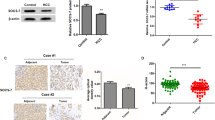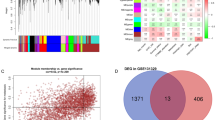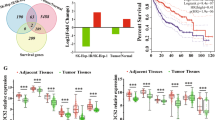Abstract
Suppressor of cytokine signaling 1 (SOCS1) is considered as a tumor suppressor protein in hepatocellular carcinoma (HCC), but the underlying mechanisms remain unclear. Previously, we have shown that SOCS1-deficient hepatocytes displayed increased responsiveness to hepatocyte growth factor (HGF) due to enhanced signaling via the MET receptor tyrosine kinase. As aberrant MET activation occurs in many tumors including HCC, here we elucidated the mechanisms of SOCS1-mediated regulation. SOCS1 attenuated HGF-induced proliferation of human and mouse HCC cell lines and their growth as tumors in NOD.scid.gamma mice. Tumors formed by SOCS1 expressing HCC cells showed significantly reduced MET expression, indicating that SOCS1 not only attenuates MET signaling but also regulates MET expression. Mechanistically, SOCS1 interacted with MET via the Src homology 2 domain and this interaction was promoted by MET tyrosine kinase activity. The SOCS1-mediated reduction in MET expression does not require the juxtamembrane Y1003 residue implicated in Cbl-mediated downmodulation. Moreover, the proteasome inhibitor MG-132, but not the inhibitors of lysosomal degradation bafilomycin and chloroquine, reversed the SOCS1-mediated reduction in MET expression, indicating that this process is distinct from Cbl-mediated downmodulation. Accordingly, SOCS1 promoted polyubiquitination of MET via K48-dependent but not K63-mediated ubiquitin chain elongation. Furthermore, siRNA-mediated downmodulation of Cbl did not abolish SOCS1-mediated reduction in MET expression in HCC cells. SOCS1-dependent ubiquitination of endogenous MET receptor occurred rapidly following HGF stimulation in HCC cells, leading to proteasomal degradation of phosphorylated MET receptor. These findings indicate that SOCS1 mediates its tumor suppressor functions, at least partly, by binding to MET and interfering with downstream signaling pathways as well as by promoting the turnover of the activated MET receptor. We propose that loss of this control mechanism due to epigenetic repression of SOCS1 could contribute to oncogenic MET signaling in HCC and other cancers, and that MET inhibitors might be useful in treating these patients.
This is a preview of subscription content, access via your institution
Access options
Subscribe to this journal
Receive 50 print issues and online access
$259.00 per year
only $5.18 per issue
Buy this article
- Purchase on Springer Link
- Instant access to full article PDF
Prices may be subject to local taxes which are calculated during checkout







Similar content being viewed by others
References
Yoshikawa H, Matsubara K, Qian GS, Jackson P, Groopman JD, Manning JE et al. SOCS-1, a negative regulator of the JAK/STAT pathway, is silenced by methylation in human hepatocellular carcinoma and shows growth- suppression activity. Nat Genet 2001; 28: 29–35.
Yoshida T, Ogata H, Kamio M, Joo A, Shiraishi H, Tokunaga Y et al. SOCS1 is a suppressor of liver fibrosis and hepatitis-induced carcinogenesis. J Exp Med 2004; 199: 1701–1707.
Inagaki-Ohara K, Kondo T, Ito M, Yoshimura A . SOCS, inflammation, and cancer. JAKSTAT 2013; 2: e24053.
Kazi JU, Kabir NN, Flores-Morales A, Ronnstrand L . SOCS proteins in regulation of receptor tyrosine kinase signaling. Cell Mol Life Sci 2014; 71: 3297–3310.
Gui Y, Yeganeh M, Ramanathan S, Leblanc C, Pomerleau V, Ferbeyre G et al. SOCS1 controls liver regeneration by regulating HGF signaling in hepatocytes. J Hepatol 2011; 55: 1300–1308.
Comoglio PM, Giordano S, Trusolino L . Drug development of MET inhibitors: targeting oncogene addiction and expedience. Nat Rev Drug Discov 2008; 7: 504–516.
Trusolino L, Bertotti A, Comoglio PM . MET signalling: principles and functions in development, organ regeneration and cancer. Nat Rev Mol Cell Biol 2010; 11: 834–848.
Mak HH, Peschard P, Lin T, Naujokas MA, Zuo D, Park M . Oncogenic activation of the Met receptor tyrosine kinase fusion protein, Tpr-Met, involves exclusion from the endocytic degradative pathway. Oncogene 2007; 26: 7213–7221.
Kermorgant S, Parker PJ . Receptor trafficking controls weak signal delivery: a strategy used by c-Met for STAT3 nuclear accumulation. J Cell Biol 2008; 182: 855–863.
Abella JV, Parachoniak CA, Sangwan V, Park M . Dorsal ruffle microdomains potentiate Met receptor tyrosine kinase signaling and down-regulation. J Biol Chem 2010; 285: 24956–24967.
Jeffers M, Taylor GA, Weidner KM, Omura S, Vande Woude GF . Degradation of the Met tyrosine kinase receptor by the ubiquitin-proteasome pathway. Mol Cell Biol 1997; 17: 799–808.
Hammond DE, Urbe S, Vande Woude GF, Clague MJ . Down-regulation of MET, the receptor for hepatocyte growth factor. Oncogene 2001; 20: 2761–2770.
Alexander WS . Suppressors of cytokine signalling (SOCS) in the immune system. Nat Rev Immunol 2002; 2: 1–7.
Johnston JA . Are SOCS suppressors, regulators, and degraders? J Leukoc Biol 2004; 75: 743–748.
Okumura F, Matsuzaki M, Nakatsukasa K, Kamura T . The role of elongin BC-containing ubiquitin ligases. Front Oncol 2012; 2: 10.
Seki E, Kondo Y, Iimuro Y, Naka T, Son G, Kishimoto T et al. Demonstration of cooperative contribution of MET- and EGFR-mediated STAT3 phosphorylation to liver regeneration by exogenous suppressor of cytokine signalings. J Hepatol 2008; 48: 237–245.
Ilangumaran S, Ramanathan S, Rottapel R . Regulation of the immune system by SOCS family adaptor proteins. Semin Immunol 2004; 16: 351–365.
Zhu H, Naujokas MA, Park M . Receptor chimeras indicate that the met tyrosine kinase mediates the motility and morphogenic responses of hepatocyte growth/scatter factor. Cell Growth Differ 1994; 5: 359–366.
De Sepulveda P, Okkenhaug K, Rose JL, Hawley RG, Dubreuil P, Rottapel R . Socs1 binds to multiple signalling proteins and suppresses steel factor-dependent proliferation. EMBO J 1999; 18: 904–915.
Peschard P, Fournier TM, Lamorte L, Naujokas MA, Band H, Langdon WY et al. Mutation of the c-Cbl TKB domain binding site on the Met receptor tyrosine kinase converts it into a transforming protein. Mol Cell 2001; 8: 995–1004.
Grassian AR, Schafer ZT, Brugge JS . ErbB2 stabilizes epidermal growth factor receptor (EGFR) expression via Erk and Sprouty2 in extracellular matrix-detached cells. J Biol Chem 2011; 286: 79–90.
Woelk T, Sigismund S, Penengo L, Polo S . The ubiquitination code: a signalling problem. Cell Div 2007; 2: 11.
Thien CB, Langdon WY . c-Cbl and Cbl-b ubiquitin ligases: substrate diversity and the negative regulation of signalling responses. Biochem J 2005; 391: 153–166.
Haglund K, Sigismund S, Polo S, Szymkiewicz I, Di Fiore PP, Dikic I . Multiple monoubiquitination of RTKs is sufficient for their endocytosis and degradation. Nat Cell Biol 2003; 5: 461–466.
Zardo G, Tiirikainen MI, Hong C, Misra A, Feuerstein BG, Volik S et al. Integrated genomic and epigenomic analyses pinpoint biallelic gene inactivation in tumors. Nat Genet 2002; 32: 453–458.
Jiang S, Zhang HW, Lu MH, He XH, Li Y, Gu H et al. MicroRNA-155 functions as an OncomiR in breast cancer by targeting the suppressor of cytokine signaling 1 gene. Cancer Res 2010; 70: 3119–3127.
Babar IA, Cheng CJ, Booth CJ, Liang X, Weidhaas JB, Saltzman WM et al. Nanoparticle-based therapy in an in vivo microRNA-155 (miR-155)-dependent mouse model of lymphoma. Proc Natl Acad Sci USA 2012; 109: E1695–E1704.
Kobayashi N, Uemura H, Nagahama K, Okudela K, Furuya M, Ino Y et al. Identification of miR-30d as a novel prognostic maker of prostate cancer. Oncotarget 2012; 3: 1455–1471.
Straussman R, Morikawa T, Shee K, Barzily-Rokni M, Qian ZR, Du J et al. Tumour micro-environment elicits innate resistance to RAF inhibitors through HGF secretion. Nature 2012; 487: 500–504.
Wilson TR, Fridlyand J, Yan Y, Penuel E, Burton L, Chan E et al. Widespread potential for growth-factor-driven resistance to anticancer kinase inhibitors. Nature 2012; 487: 505–509.
Casaletto JB, McClatchey AI . Spatial regulation of receptor tyrosine kinases in development and cancer. Nat Rev Cancer 2012; 12: 387–400.
Karamouzis MV, Konstantinopoulos PA, Papavassiliou AG . Targeting MET as a strategy to overcome crosstalk-related resistance to EGFR inhibitors. Lancet Oncol 2009; 10: 709–717.
Xu AM, Huang PH . Receptor tyrosine kinase coactivation networks in cancer. Cancer Res 2010; 70: 3857–3860.
Gherardi E, Birchmeier W, Birchmeier C, Vande Woude G . Targeting MET in cancer: rationale and progress. Nat Rev Cancer 2012; 12: 89–103.
Peschard P, Park M . From Tpr-Met to Met, tumorigenesis and tubes. Oncogene 2007; 26: 1276–1285.
Longva KE, Blystad FD, Stang E, Larsen AM, Johannessen LE, Madshus IH . Ubiquitination and proteasomal activity is required for transport of the EGF receptor to inner membranes of multivesicular bodies. J Cell Biol 2002; 156: 843–854.
Zhou L, Yang H . The von Hippel-Lindau tumor suppressor protein promotes c-Cbl-independent poly-ubiquitylation and degradation of the activated EGFR. PLoS One 2011; 6: e23936.
Lin WW, Karin M . A cytokine-mediated link between innate immunity, inflammation, and cancer. J Clin Invest 2007; 117: 1175–1183.
Fausto N, Campbell JS, Riehle KJ . Liver regeneration. Hepatology 2006; 43: S45–S53.
Goyal L, Muzumdar MD, Zhu AX . Targeting the HGF/c-MET pathway in hepatocellular carcinoma. Clin Cancer Res 2013; 19: 2310–2318.
Esteller M . Aberrant DNA methylation as a cancer-inducing mechanism. Annu Rev Pharmacol Toxicol 2005; 45: 629–656.
Fukushima N, Sato N, Sahin F, Su GH, Hruban RH, Goggins M . Aberrant methylation of suppressor of cytokine signalling-1 (SOCS-1) gene in pancreatic ductal neoplasms. Br J Cancer 2003; 89: 338–343.
Shakya R, Gonda T, Quante M, Salas M, Kim S, Brooks J et al. Hypomethylating therapy in an aggressive stroma-rich model of pancreatic carcinoma. Cancer Res 2013; 73: 885–896.
Yasukawa H, Misawa H, Sakamoto H, Masuhara M, Sasaki A, Wakioka T et al. The JAK-binding protein JAB inhibits Janus tyrosine kinase activity through binding in the activation loop. EMBO J 1999; 18: 1309–1320.
Ilangumaran S, Finan D, La Rose J, Raine J, Silverstein A, De Sepulveda P et al. A positive regulatory role for SOCS1 in interferon gamma-induced MHC class II expression in fibroblasts. J Immunol 2002; 169: 5010–5020.
Lim KL, Chew KC, Tan JM, Wang C, Chung KK, Zhang Y et al. Parkin mediates nonclassical, proteasomal-independent ubiquitination of synphilin-1: implications for Lewy body formation. J Neurosci 2005; 25: 2002–2009.
Acknowledgements
We thank Dr Morag Park for generously providing CSF-MET and Tpr-MET expression plasmids. Centre de Recherche Clinique du CHUS is an FRSQ-funded research center. This work was supported by the Cancer Research Society, Montreal, Canada (SI and CS).
Author information
Authors and Affiliations
Corresponding author
Ethics declarations
Competing interests
YG is a recipient of a graduate student fellowship from the Canadian Liver Foundation. MY was a recipient of FRQNT doctoral fellowship. All other authors declare no conflict of interest.
Additional information
Supplementary Information accompanies this paper on the Oncogene website
Supplementary information
Rights and permissions
About this article
Cite this article
Gui, Y., Yeganeh, M., Donates, YC. et al. Regulation of MET receptor tyrosine kinase signaling by suppressor of cytokine signaling 1 in hepatocellular carcinoma. Oncogene 34, 5718–5728 (2015). https://doi.org/10.1038/onc.2015.20
Received:
Revised:
Accepted:
Published:
Issue Date:
DOI: https://doi.org/10.1038/onc.2015.20
This article is cited by
-
ORP5 promotes tumor metastasis via stabilizing c-Met in renal cell carcinoma
Cell Death Discovery (2022)
-
Prognostic significance of SOCS1 and SOCS3 tumor suppressors and oncogenic signaling pathway genes in hepatocellular carcinoma
BMC Cancer (2020)
-
Expression of SOCS1 and the downstream targets of its putative tumor suppressor functions in prostate cancer
BMC Cancer (2017)
-
SOCS1 inhibits migration and invasion of prostate cancer cells, attenuates tumor growth and modulates the tumor stroma
Prostate Cancer and Prostatic Diseases (2017)
-
SOCS2 Binds to and Regulates EphA2 through Multiple Mechanisms
Scientific Reports (2017)



